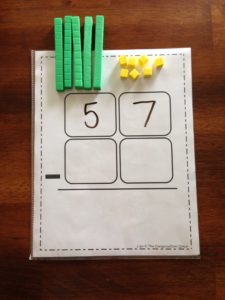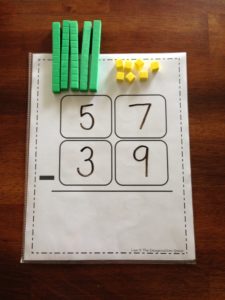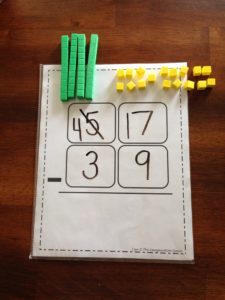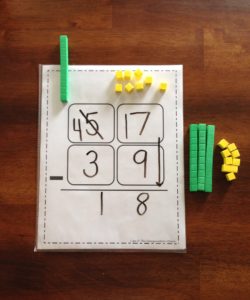Number sense? I definitely didn’t have it as child. I sometimes question if I even do now! I never learned to look at numbers as a meaningful part of my day until I needed to double check a calculation on a pay check. I honestly spent a large part of my early elementary years confused with catchy subtraction reminders like “bottom bigger, better borrow” and “When the big one’s on the top, no need to stop. When the big one’s on the floor, go next door.” Say what?! When I heard “big one’s on the floor, go next door” in my 7 year old world, it meant to run to the neighbor for help ’cause someone took a fall. For real!
Number sense is a student’s ability to understand numbers and use them flexibly. I’m fully convinced that understanding math is not about memorizing catchy phrases or passively receiving information. Learning math is about experiencing, using all the senses. As educators, we know number sense develops as children grow through actively engaging with numbers. Days spent purposefully asking questions about numbers help to provide this foundation. As a parent, frequently ask your child to count, estimate, and perform mental math. Involve them in discussions about different ways to find answers to math problems. In this way, some children will really grow to love math because it’s fun (huh?!) and reliable.
A large part of focus during my son’s foundational years was math experiences. Nothing intense that involved actual pencil and paper. We spent a lot of time looking at numbers-taking numbers apart and putting them back together. We counted objects, discussed prices and quantities, made estimations, etc. I use Elizabeth Hainstock’s Teaching Montessori In the Home: The Preschool Years as a guide for early math learning. In this book, she discusses the importance of sensory experiences in mathematics. I tried to provide these as a part of our routine, creating number rods and sandpaper numbers.
But what happens when you want to transition mental math into a pencil and paper drill? Double digit subtraction lends itself well to this idea of “showing your work.” I created two simple math mats for addition and subtraction problems. Once he had manipulatives to work with, he understood the connection to the marks he was making on the paper. We’ve used these base ten blocks from day one!
Need a little help getting started? Get your FREE math mat right here! Yay! It’s simple and awesome. I know because I made it 🙂
Below is an example of how I use the mats with a subtraction problem. We’ll use 57-39. I ALWAYS ask students to build the minuend (the first number in the subtraction problem) with the base ten blocks FIRST in order to help them understand that there isn’t enough ones to take away 9. After they’ve built the number with the base ten blocks, allow them to explore it. This is their sensory experience! Take a minute to brainstorm ways to solve this problem. Point out that there isn’t enough ones. Ask for ideas, suggestions, and input. Next, review the positions of the tens and ones place on the math mat. Place the cubes above the numbers as shown here. Demonstrate where to correctly write each digit on the mat.
 Next write the subtrahend (39, what’s being taken away) underneath in the correct boxes. Remind students that the number on the top of the ones column (7) is fewer than the (9) and that we can’t take 9 away from 7. Explain that you’ll have to “borrow” a ten rod from the 5 that’s in the tens place.
Next write the subtrahend (39, what’s being taken away) underneath in the correct boxes. Remind students that the number on the top of the ones column (7) is fewer than the (9) and that we can’t take 9 away from 7. Explain that you’ll have to “borrow” a ten rod from the 5 that’s in the tens place.

Get ready, Math Genuises! This is when the magic happens! When students remove a ten rod, mark out the 5 and write in number 4. Replace the ten rod with 10 units above the ones column. At the same time, have them mark a “1” in front of the number 7. Have them count all the ones units to confirm that there are now 17.

Talk this up, peeps! “Wow! Look at that! You have 17 ones. See how wrote a “1” here to show that you borrowed a ten? Now you have 17 ones!” Brainstorm with students what to do next before moving on. Demonstrate the actual subtraction happening by moving 3 rods and 9 units down. Count what is left at the top. Draw an arrow down to show students where to place the answer. Explain how to subtract from the ones column first.

And just like that. Math = fun and reliable!
This post contains Amazon Affiliate links.









